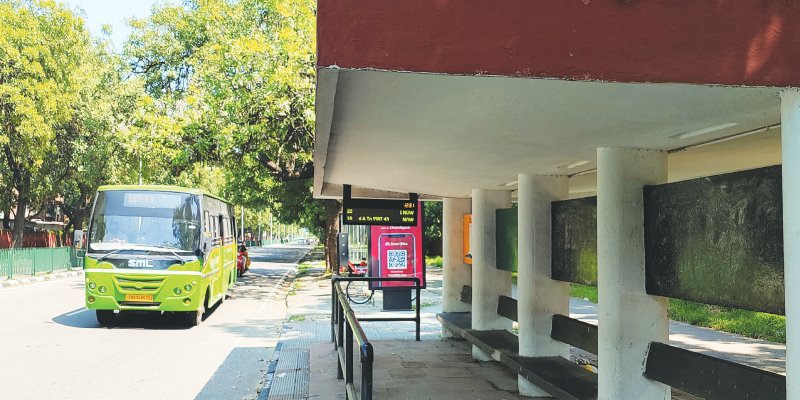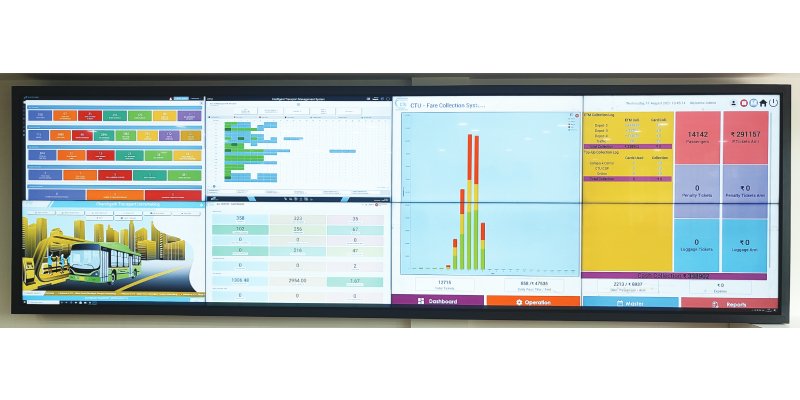Amnex solutions optimize operations of AICTSL; make public transport journeys accurate and reliable

Indore, a fast-growing industrial city of Madhya Pradesh had been deprived of robust public transportation service for a long. It was in 2005, AICTSL (Atal Indore City Transport Service Limited) introduced organized public transport services using city buses, midi buses, BRT ibuses and sky bus services. The commuters that had to resort to tempos and Nagar Seva for public transport, affably adapt to the new modes of transport.
Since its inception, AICTSL has been dedicated to delivering effective services to commuters and had been a frontrunner in adopting technology solutions that enhance the commuting experience. The city transport service aims to cater to 500,000 daily customers. In order to rationally plan and operate the network of 200+ buses covering 227 km of the road network, AICTSL wanted technology solutions that could make the services more reliable and efficient. The aim was to reduce congestion, pollution, accidents and delays by encouraging the use of public transportation. AICTSL wanted a mobile application to aid its users with journey planning. To increase safety, it was important to install CCTV surveillance at all BRT stations. AICTSL wanted to make the ticketing process quick and hassle-free by introducing smart cards and e-tickets. The ultimate goal was to make bus services more accessible to the citizens. Amnex’s ITMS (Intelligent Transit Management System) helped AICTSL achieve this goal within a short span.
Amnex implemented the below-mentioned solutions in the project:
- Automatic Vehicle Location System (AVLS) to track the vehicles in real-time.
- Incident Management System (IMS) to enable administrators to visualize possible emergencies and monitor compliance violations.
- Planning and Scheduling (P&S) System to enable transit authorities to efficiently plan and manage services, duties. It also helps in roster/dispatch management and route optimization.
- Passenger Information and Communication (PIC) system to display real-time information such as ETA/ETD, location of the vehicles, delay notifications, service disruptions, emergency/awareness messages etc.
- A comprehensive web portal and a journey planner app for commuters to check the real-time schedules, find the nearest transit options, file grievances, purchase tickets and recharge smart cards or passes.
- Automatic Fare Collection System (AFCS) or smart ticketing system to enable commuters to purchase tickets through multiple modes of payment like cash, cards, e-wallet, QR code scanning etc.
- Fare gates, PoS machines, ETM, SCPC (Smart Card Personalization Centre) to create a robust digital payment ecosystem.
- ICCC (Integrated Command and Control Centre), a state-of-the-art traffic management centre with a video wall to help authorities manage services with utmost efficiency.
- Surveillance management system to increase safety of the commuters.
- In-bus announcement/display to inform commuters about the upcoming stops.
- Fibre-based connectivity between BRT stations and Command Control Centre.
The solutions implemented by Amnex improved the service environment, planning and management at all levels. As a result, the reliability and efficiency of the public transport vehicles increased multifold. It, in turn, attracted more commuters to choose public transport over other modes of travel.

Some of the most visible benefits of the project have been
- It made public transport commuting within the city seamless and more efficient. It was now safer, less polluting, economical and better planned.
- It expanded the reach of public transit systems by enabling transit authorities to optimally plan routes based on the commuters’ patterns.
- It enabled authorities to make informed decisions based on real-time and historical data.
- The incidents within the cities were managed faster and more efficiently.
- It created a coordinated and managed service environment for operations staff and management. It further facilitated connectivity between the driver, control room and specified officials.
- It enabled managers to monitor the entire fleet operations efficiently by raising alerts about service non-adherence, irregularities in revenue reports or the functioning of equipment.
- Dashboard driven operations and revenue data for the top management helped review the performance of the services, and make timely and informed decisions.
- It helped reduce the usage of personal vehicles, improving the air quality of the city.
- The ridership of the buses increased day by day.
- Automatic ticketing using QR codes, smart cards and tokens saved commuters’ time and ensured zero revenue leakage.
- It boosted multi-modal transport within the city.
– Amnex’s ITMS solutions are scalable, future-ready and tested to support fleet size of 15,000+ buses.
– AFCS System is compatible with open-loop payment system & NCMC standards with minimum customisation. It supports EMV & RuPay cards as per the stated requirements.
– It is compatible with NFC (Near Field Communication) technology.
– It is compatible with other modes of transportation such as city cab service, auto-rickshaws etc.
– It can cater to the requirements of other utility services of smart cities such as Solid Waste Management, emergency rescue operations such as fire, ambulance, police, traffic control etc.
– It is a platform for futuristic common pre-payment cards for tourists across the city for accessing public places, amusement parks etc.
– It is compatible with various IoT platform vendors and enables seamless integration for future requirements with minimal effort.
– It is compatible with GIS-based third-party mapping platforms.
How Amnex solutions are transforming the processes of AICTSL:
- ITMS solutions installed and integrated in 250+ buses
- 40 Multicolour PIS display units installed
- 406 ETMs used for on-board and off-board ticketing
- 25 POS & 75 fare-gates for off-board ticketing using QR scanning, tokens and smart cards
- Monthly 1.6 million+ ridership managed
- Paperless ticketing and digital transactions enabled with 2,25,000 smart fare media i.e smart cards & tokens
 TrafficInfraTech Magazine Linking People Places & Progress
TrafficInfraTech Magazine Linking People Places & Progress


